Located in Western Canada, Alberta is a province that shares borders with British Columbia to the west, Saskatchewan to the east, the Northwest Territories (NWT) to the north, and the U.S. state of Montana to the south. Alberta’s cold climate isn’t exactly a tropical paradise for snakes, but it’s also not devoid of these slithering residents either. Think of Alberta as a rather exclusive club when it comes to snake membership. At least six species call this Canadian province home. So buckle up, we’ll be covering the following six “snake-infested” lakes in Alberta, and the snakes that live there too!
1. Sylvan Lake

Sylvan Lake is an enchanting destination where you can soak up the sun, indulge in water-based adventures, and appreciate the beauty of nature.
©Dean Fikar/Shutterstock.com
Nestled in the heart of Central Alberta, Sylvan Lake is a captivating tourist spot with a unique history. Back in the late 1800s, when French immigrants first settled here, the lake earned the nickname “Snake Lake” due to its abundant garter snake population. Although the name was later changed to Sylvan Lake, it still retains its charm and attracts visitors from far and wide. Today, Sylvan Lake is home to a diverse range of wildlife, including the occasional garter snake. However, these harmless slithering creatures are quite shy and tend to keep to themselves.
2. Lake Louise

The picturesque beauty of Lake Louise makes it one of the most photographed lakes in the world.
©BGSmith/Shutterstock.com
Lake Louise is a glacial lake in Banff National Park in Alberta, Canada. The scenery is simply awe-inspiring, nestled amidst towering mountains like Mount Victoria, Mount Lefroy, and Mount Saint Piran. The striking contrast between the lake’s vivid turquoise hue and the white-gray backdrop of the mountains creates a captivating vista. The lake’s history stretches back to the Ice Age when a glacier sculpted its breathtaking path through the Rocky Mountains. As time passed, the glacier melted, leaving behind this exquisite lake that we behold today. The Stoney Nakoda people, the first inhabitants of the Lake area, referred to it as “Ho-run-num-nay,” or the “lake of the little fishes.”
Don’t worry too much about encountering snakes at Lake Louise. While there aren’t many of them, a few garter snakes are hanging around. Specifically, you might come across the red-sided garter snake (Thamnophis sirtalis), which happens to be quite common in Alberta. So, although the chances of encountering one are slim, it’s good to know that these little reptiles are part of the local fauna.
3. Moraine Lake

Located in Banff National Park, Moraine Lake is nestled in the Valley of the Ten Peaks.
©Invisible Witness/Shutterstock.com
This enchanting destination sits at an elevation of approximately 6,181 feet and spans across a surface area of approximately 120 acres. Renowned for its mesmerizing turquoise waters and breathtaking mountain vistas, Moraine Lake owes its striking hue to the reflection of sunlight off suspended rock flour in the water. This rock flour, a product of the glaciers that nourish the lake, imparts a milky appearance to the water’s surface. Over thousands of years, the gradual retreat of glaciers shaped the basin of Moraine Lake and deposited the rock flour that grants it its magnificent turquoise color. Adding to its rich history, the lake’s early inhabitants were the Stoney Nakoda people, who referred to it as “Wapta,” meaning “valley of the ten peaks.”
While the snake population in the area is relatively small, you might still come across a few garter snakes. The most commonly spotted one is the red-sided garter snake. On occasion, you might also see a wandering garter snake (Thamnophis elegans).
4. Peyto Lake

The beautiful backdrop of Peyto Lake includes majestic peaks such as Mount Richardson, Mount Peyto, and Mount Whyte.
©TRphotos/Shutterstock.com
Peyto Lake is a mesmerizing glacier-fed lake. Nestled along the Icefields Parkway, just about 25 miles (40 kilometers) north of Lake Louise, Peyto Lake is renowned for its captivating turquoise waters. This enchanting hue is a result of sunlight reflecting off the suspended rock flour in the lake. Crafted by the feeding glaciers, this rock flour creates a milky appearance in the water. The indigenous Stoney Nakoda people were the original inhabitants of this area, who aptly named the lake “Peyto Bow,” signifying its vivid azure hue.
Within the glistening waters of Peyto Lake itself, snakes are a rare sight. However, do keep in mind that the surrounding area is home to a few snake species, such as the common garter snake and the red-sided garter snake. These snakes have a penchant for habitats with tall grass or areas near water, where they can seek shelter and find their prey.
5. Minnewanka Lake

Minnewanka Lake is situated 3.1 miles northeast of the charming Banff townsite.
©iStock.com/Jacek_Sopotnicki
Located in the awe-inspiring Banff National Park in Alberta, Lake Minnewanka showcases unparalleled natural beauty. This expansive glacial lake stretches a remarkable 13 miles in length and plunges into mesmerizing depths of 466 feet. As one of the longest lakes in the legendary Canadian Rockies, Lake Minnewanka boasts an illustrious past. The first inhabitants of this area were the Stoney Nakoda people, who reverently referred to it as “Minn-waki” or the “Lake of the Spirits.” For the Stoney Nakoda, this sacred lake was believed to be inhabited by mystical entities, adding to its spiritual significance. Uniting history, natural grandeur, and cultural heritage, Lake Minnewanka remains an enduring testament to the allure of the Canadian Rockies.
The only snakes you’ll find wandering in and around Lake Minnewanka are garter snakes. These snakes are often active during the day, swimming or sunbathing on nearby rocks.
6. Maligne Lake

J National Park has the grandest lake, known for its stunning landscapes and abundant wildlife.
©Elena_Suvorova/Shutterstock.com
Maligne Lake, nestled in Jasper National Park, Alberta, Canada, is a majestic glacial lake. It reigns as the largest natural lake in the Canadian Rockies, boasting breathtaking turquoise waters that owe their brilliance to nearby glaciers. Adorned by an awe-inspiring mountain panorama, Maligne Lake finds itself embraced by towering peaks such as Mount Maligne, Mount Brazeau, and Mount Edith Cavell. Its history harkens back to the Stoney Nakoda people who aptly named it “Chaba Imne,” meaning “lake of deep waters.” The lake’s tranquil shores are a haven for diverse wildlife, including grizzly bears, moose, elk, and mountain goats. For adventurers seeking unforgettable vistas, the hiking trails that trace the shoreline of Maligne Lake offer unparalleled views that leave a lasting impression of nature’s grandeur.
Like many of Alberta’s lakes, the only snakes that typically live in and around Maligne Lake are garter snakes. Although typically shy, garter snakes can bite if they feel threatened. But don’t worry, they aren’t venomous.
| Lakes | Location | Some Notable Features |
|---|---|---|
| 1. Sylvan Lake | Central Alberta | One of the most popular lakes in the region for swimming, kayaking, and boating. |
| 2. Lake Louise | Banff National Park | Awe-inspiring turquoise waters, embraced by the breathtaking embrace of majestic mountains. |
| 3. Moraine Lake | Banff National Park | The sparkling turquoise waters, embraced by majestic mountains and fed by pristine glaciers, create a captivating oasis of natural beauty. |
| 4. Peyto Lake | Icefields Parkway in Banff National Park | Breathtaking beauty of vibrant blue waters and majestic mountain vistas. |
| 5. Minnewanka Lake | Banff National Park | Stunning scenery, and recreational activities. |
| 6. Maligne Lake | Jasper National Park | Abundant wildlife, and breathtaking scenery. The largest lake in the park captivates with its beauty. |
Six Canadian Snakes Infesting Lakes In Alberta
Nestled in the heart of Canada, Alberta boasts an array of breathtaking natural wonders and an enchanting variety of wildlife. The province is teeming with captivating creatures, including six distinct species of snakes. These intriguing reptiles contribute to the already abundant biodiversity of this remarkable Canadian province. And many of them can be spotted in and around the scenic lakes that grace Alberta’s landscape!
1. Bullsnake (Pituophis catenifer sayi)
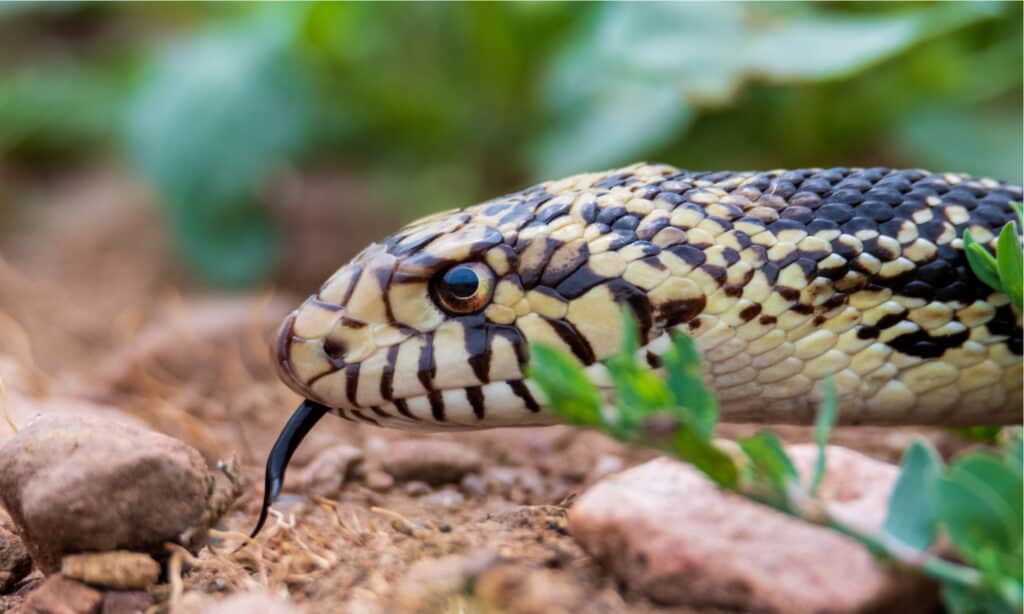
The impressive bullsnake has a protective shield on its nose, aiding it in its natural digging abilities.
©Greg Birkett/Shutterstock.com
The bullsnake is a non-venomous serpent found in Alberta, Canada. It is one of the largest snake species in the province, reaching lengths of over 6.5 feet. Bullsnakes exhibit shades of brown or yellow, adorned with dark blotches along their backs and sides. With a broad head and a short tail, these adaptable reptiles thrive in various habitats, from grasslands to forests and wetlands. They are versatile eaters, consuming a diverse diet that includes rodents, rabbits, squirrels, birds, reptiles, and even eggs. Active both day and night, bullsnakes mate during springtime, with females laying eggs in the summer. Come fall, the young serpents emerge from their eggs and are left to fend for themselves, starting their journey in the great wild.
2. Plains Garter Snake (Thamnophis radix)
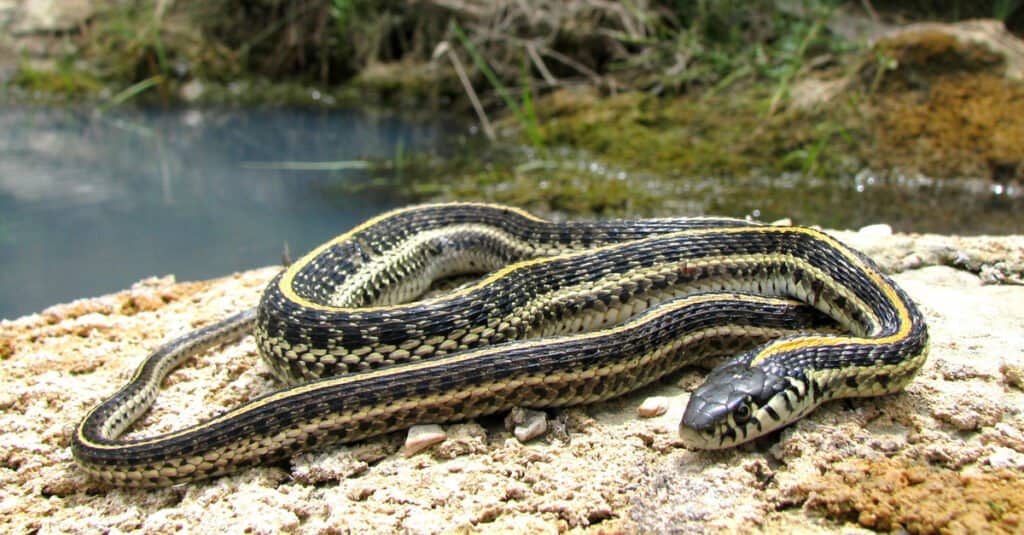
©Joe Farah/Shutterstock.com
The plains garter snake is a common non-venomous snake in Alberta, Canada. It thrives in moist habitats like meadows, wetlands, and riparian areas, even venturing into urban spaces such as parks and gardens. Sporting shades of brown or olive green, with a distinctive yellow stripe down its back and lighter stripes on each side, it can reach lengths of up to 40 inches, but most adults typically measure between 24 and 31 inches. As carnivores, their diet consists primarily of amphibians, including frogs and toads, while also relishing earthworms, fish, and small mammals. Employing an ambush strategy, they lie in wait for their prey before striking with precision, enwrapping their bodies to constrict and render them lifeless.
3. Red-Sided Garter Snake (Thamnophis sirtalis)
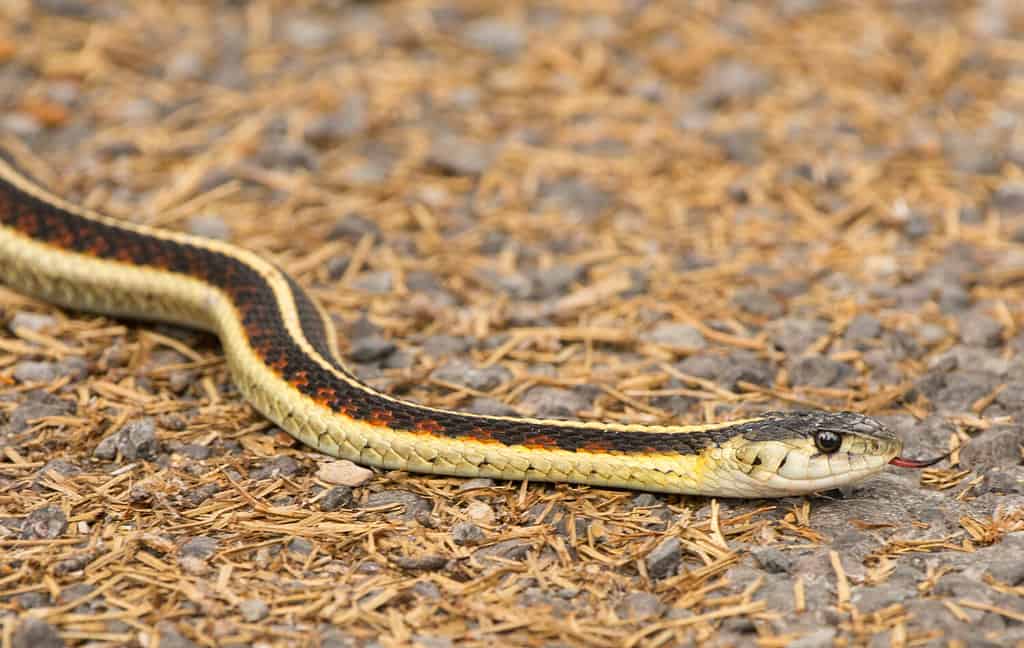
Measuring between 18 and 30 inches in length, these snakes possess a relatively modest stature compared to other snake species.
©Jennifer Bosvert/Shutterstock.com
The red-sided garter snake is a captivating creature that boasts vibrant colors, remarkable resilience, and intriguing social behaviors. Recognized as one of the most sociable snakes in the world, these serpents can often be spotted basking together in the sun. These snakes possess striking stripes that gracefully traverse their bodies. These enchanting markings serve a purpose beyond mere aesthetics — they enable the snake to seamlessly blend into its surroundings. Indigenous to North America, these garter snakes flourish in the expansive Great Plains and even venture into portions of Canada, such as Alberta.
4. Wandering Garter Snake (Thamnophis elegans vagrans)
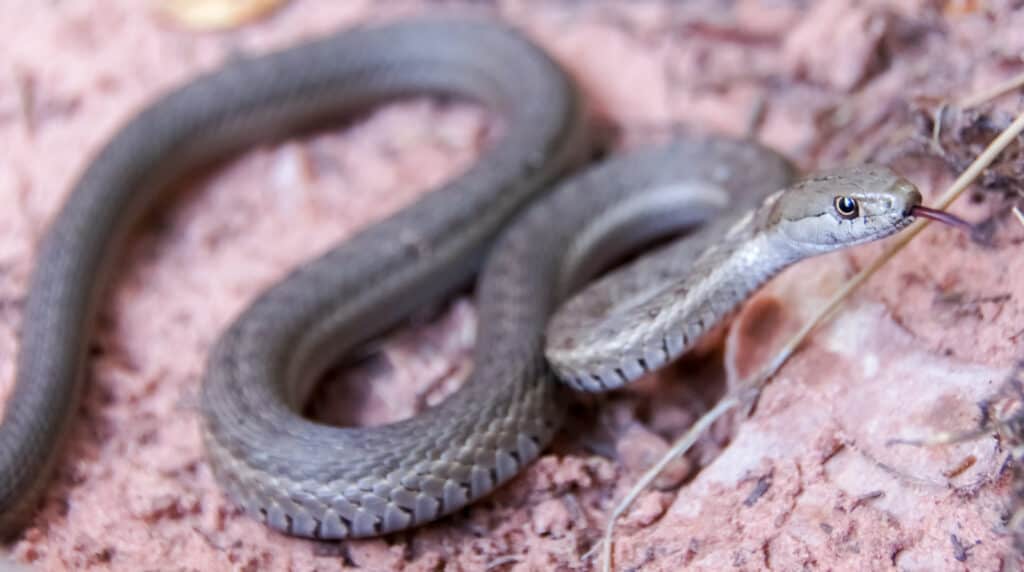
The wandering garter snake belongs to the subspecies of the western terrestrial garter snake.
©iStock.com/yhelfman
The wandering garter snake is a subspecies of the western terrestrial garter snake. Wandering garter snakes, classified as medium-sized serpents, possess distinct features such as wider heads and display opportunistic hunting behaviors. They primarily feed on amphibians, small rodents, eggs, and other reptiles, showcasing their ability to adapt to diverse habitats. Importantly, despite mild venom, these snakes do not pose a significant threat to humans. These widely distributed snakes are found across a range of environments within Alberta, Canada, including elevated terrains, coastal regions, and inland water sources.
5. Western Hog-Nosed Snake (Heterodon nasicus)
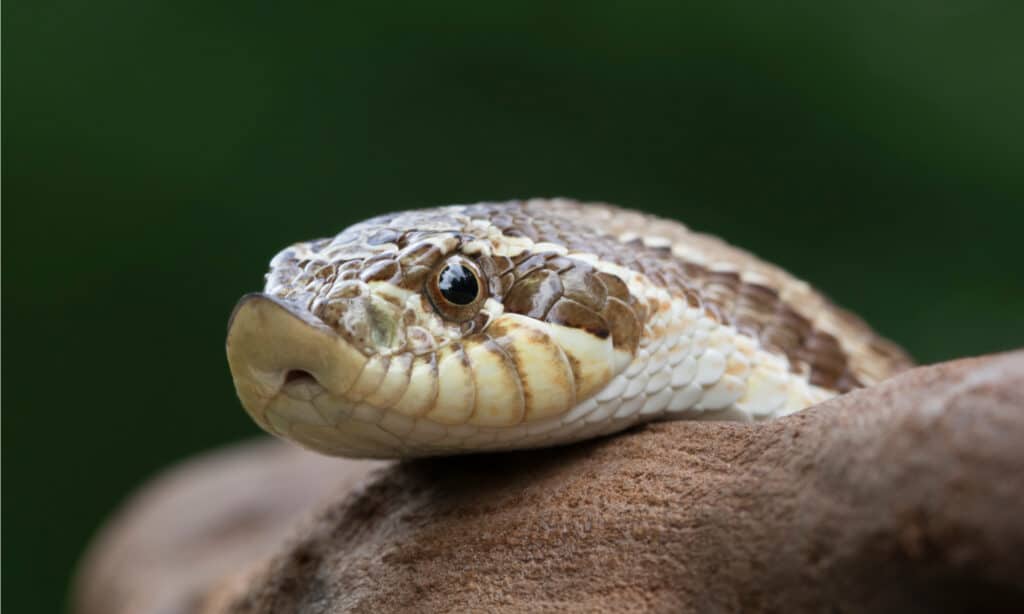
The western hognose snake has an upturned snout.
©Mark_Kostich/Shutterstock.com
The western hognose snake is a serpentine diva donning a shovel-like snout with unmatched flair. However, this snout is not just a fashion statement; it serves a crucial purpose. The western hognose snake utilizes its upturned snout to skillfully maneuver through sandy or loose soil in its relentless pursuit of delectable prey: toads. The size of these snakes typically ranges from 15 to 30 inches. Showcasing an array of vibrant patterns and colors, these creatures possess the remarkable ability to seamlessly blend into their natural habitat. Interestingly, these snakes have perfected their “tough guy” act. When faced with threats, they inflate their bodies and emit menacing hisses, aiming to appear more intimidating than they truly are. And if their act fails to intimidate, they feign death by flipping onto their back, mouth agape, and tongue hanging out.
6. Prairie Rattlesnake (Crotalus viridis)
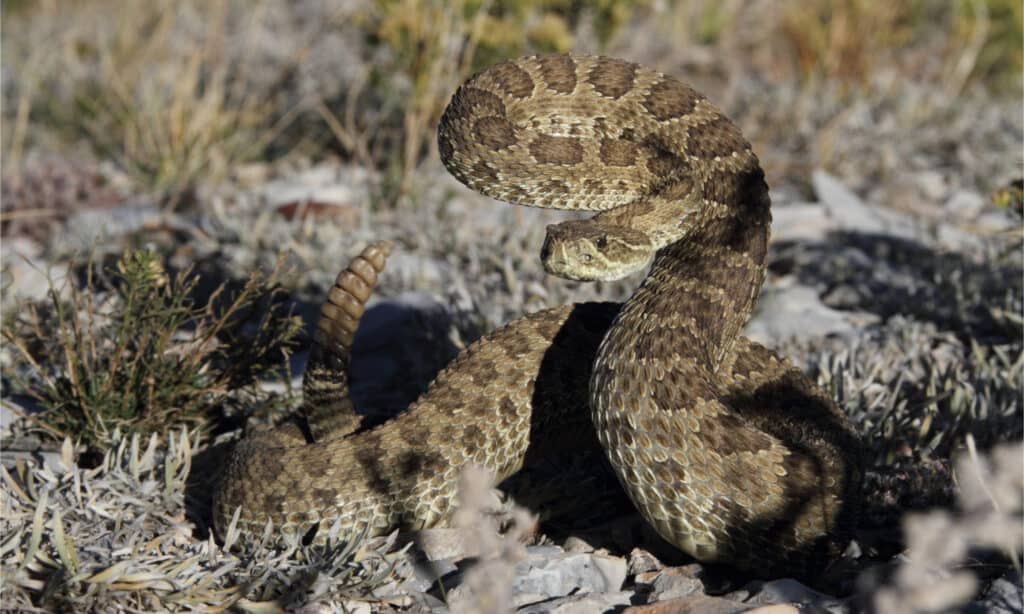
Very few people in Alberta have ever been bitten by a prairie rattlesnake.
©Harris Motion Photo/Shutterstock.com
Found in southern Alberta and Saskatchewan, the prairie rattlesnake is the only venomous species in the region. These beautiful snakes are striking, with dark brown or gray bodies adorned with a light-colored stripe running down the middle of their backs. Prairie rattlesnakes can grow up to 6 feet in length but typically are closer to 3 to 4 feet as adults. Prairie rattlesnakes are venomous and can be dangerous, but they are usually passive and shy. No one in Alberta has ever died from a prairie rattlesnake bite!
New to Alberta: Eastern Yellow-Bellied Racer (Coluber constrictor flaviventris)
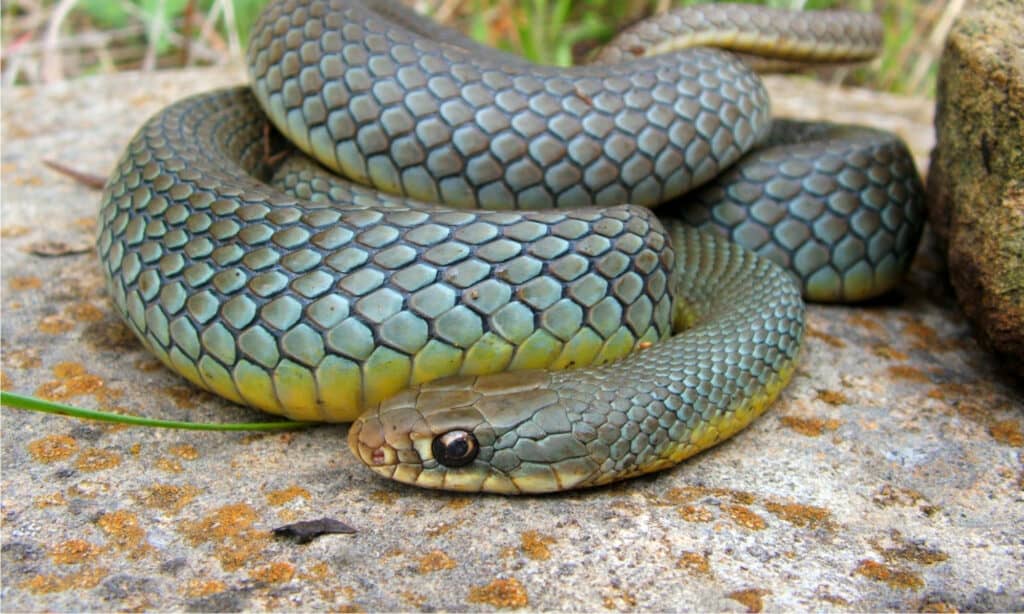
Eastern yellow-bellied racer snakes have smooth bodies with beautiful colors.
©Matt Jeppson/Shutterstock.com
Although not originally native to Alberta, the eastern yellow-bellied racer has recently been confirmed in the far southeast corner of the province. These long and slender snakes typically grow to approximately 7 feet in length, with brown or green bodies and cream or yellow bellies. Since they were only recently discovered in the region, there is not a great deal of information on these snakes thus far. Juvenile snakes have dark spots and blotches along their bodies as well.
Common Name | Scientific Name |
|---|---|
| 1. Bullsnake | Pituophis catenifer sayi |
| 2. Plains Garter Snake | Thamnophis radix |
| 3. Red-Sided Garter Snake | Thamnophis sirtalis |
| 4. Wandering Garter Snake | Thamnophis elegans vagrans |
| 5. Western Hog-Nosed Snake | Heterodon nasicus |
| 6. Prairie Rattlesnake | Crotalus viridis |
| Bonus: Eastern Yellow-Bellied Racer | Coluber constrictor flaviventris, |
If You Encounter a Snake in Alberta
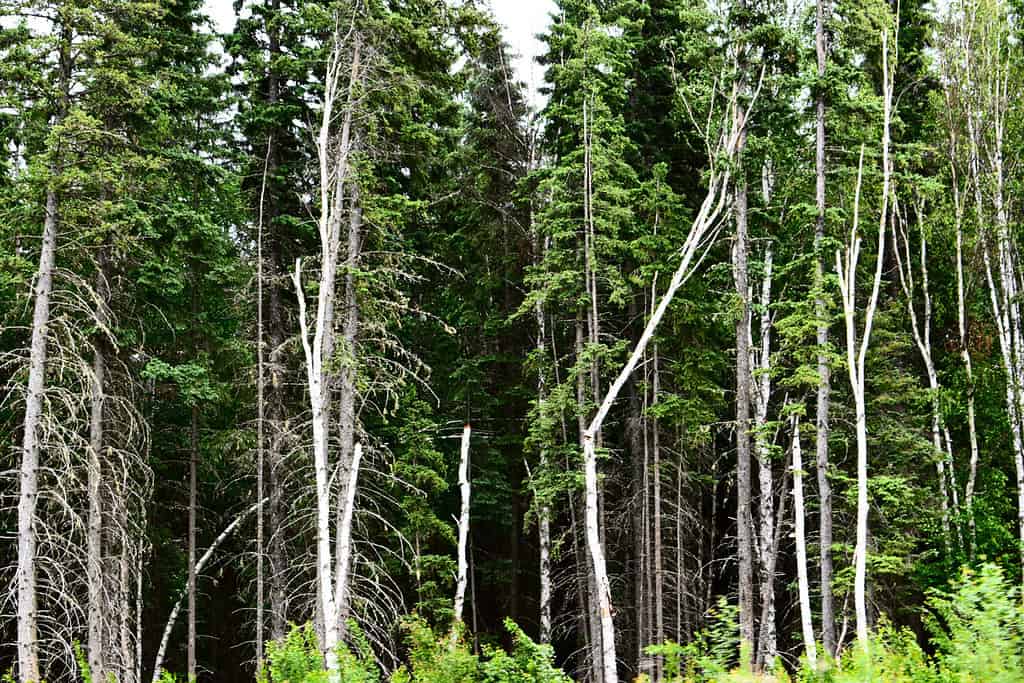
Snakes live in all types of habitats in Canada, from plains regions to marshes, forests, and even urban dwellings.
©macaulays/Shutterstock.com
As you stumble upon these fascinating creatures, it’s important to maintain a calm and composed demeanor. Instead of panicking when you encounter a snake, appreciate their unique beauty and show them the respect they deserve.
When it comes to snakes, keeping your distance is key. It’s best to simply leave them be and allow them to continue on their way. Snakes are always on the move, slithering through their natural habitats, and before you know it, they’ll be gone from your sight.
When venturing outdoors, pay attention, especially when handling equipment or moving large objects, as these might inadvertently disturb slumbering snakes. In areas where snakes are common, remember to move slowly and stay alert.
Snakes in Alberta have no malicious intentions towards us humans. However, if they feel uncomfortable, stressed, or scared, they might resort to defensive measures. So, it’s essential to respect their space and avoid causing any undue agitation.
The photo featured at the top of this post is © AutumnSkyPhotography/iStock via Getty Images
Thank you for reading! Have some feedback for us? Contact the AZ Animals editorial team.






